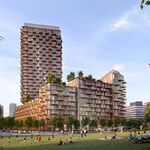Allandale25
Senior Member
What's a #20 Crossover? Also, how many ARL sets will be active on the line with 15 minute headways?
can anyone tell me when trains will be running into barrie waterfront station? i cant find it on their website, but the town website said that construction was done on Dec. 31.
What's a #20 Crossover?
Also, how many ARL sets will be active on the line with 15 minute headways?
Going back to Milton/CP, the issue with them is simply money - they are demanding more than Metrolinx thinks is fair to pay for the track time. The 8th wayside box is in place and active at Milton Yard.
Dan
Toronto, Ont.
What is a wayside box?
The ARL equipment being built by Kinki-Sharyo/Sumitomo is completely FRA- and EPA-compliant, and can run on any railway in the US or Canada. All 3 tracks will be signalized with CTC and will have #20 crossovers every couple of miles, just like on the Oakville and Kingston Subs (although it's not clear yet whether CN will be controlling it or whether it will be GO themselves).
Wayside power boxes are installed at all GO layover yards and outposts. It allows for the HEP (Head End Power) engine to be shut off. The MP40 locomotives (and the previous F59PH's) are equipped with a main engine (which drives a generator that supply's the power that propels the locomotive/train itself) and a HEP engine. The HEP engine is a smaller secondary engine which is used to supply all power to the train itself (HVAC, lighting, recharge battery backup, etc.). With wayside power, a train can be 'plugged in' so that the electrical grid supply's the power needed to maintain the HVAC while the train is in storage (also reducing diesel consumption and the need for re-fueling).
GeorgetownWayside power boxes are installed at all GO layover yards and outposts. It allows for the HEP (Head End Power) engine to be shut off. The MP40 locomotives (and the previous F59PH's) are equipped with a main engine (which drives a generator that supply's the power that propels the locomotive/train itself) and a HEP engine. The HEP engine is a smaller secondary engine which is used to supply all power to the train itself (HVAC, lighting, recharge battery backup, etc.). With wayside power, a train can be 'plugged in' so that the electrical grid supply's the power needed to maintain the HVAC while the train is in storage (also reducing diesel consumption and the need for re-fueling).



We often think that MUs are rare in North America, but the Long Island Railroad alone has over a thousand EMU cars in service today.








I dislike the name of this station "Allandale Waterfront" nearly as much as I dislike the "Vaughan Corporate Centre" and later "Vaughan Metropolitan Centre" names.




